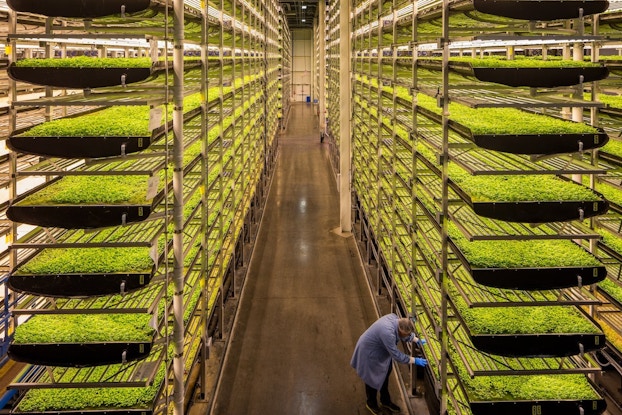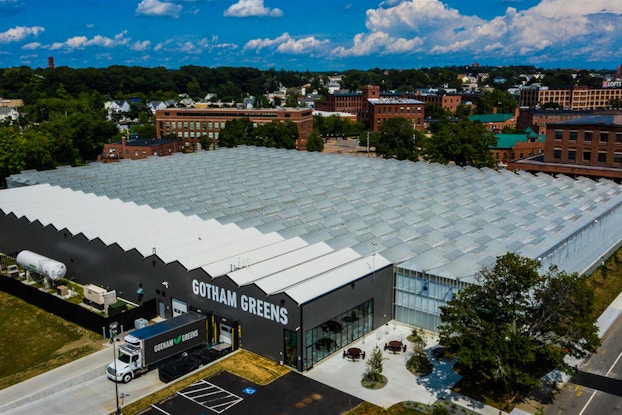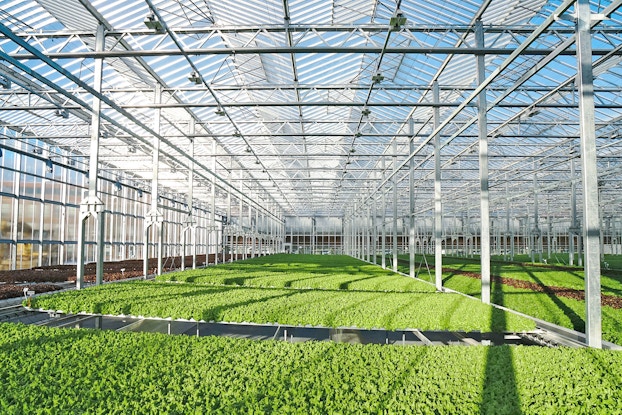
Why it matters:
- Consumer interest in local products, which has been growing for years, accelerated during the pandemic.
- Indoor farms, which provide locally grown produce to supermarkets and restaurants, have attracted significant investment to support expansion of their high-tech greenhouses.
- These facilities are also immune to weather fluctuations and other supply chain disruptions, such as those that hindered distribution during the pandemic.
Commercial indoor farms have been riding a wave of technological innovation and financial investment, as these companies seek to satisfy consumer demand for locally grown produce while at the same time reshaping the nation’s food-supply system.
Many indoor farms focus on using sustainable farming practices to grow leafy vegetables, tomatoes, herbs and berries, supplying their crops to local supermarkets and restaurants that promote their local provenance. The growers say that not only are their products more sustainable than traditionally grown crops that often travel across the country after they are harvested, but they are also less exposed to weather fluctuations and other supply chain disruptions, such as those that occurred around the world during the COVID-19 pandemic.

Interested in a small business membership?
Find out how the U.S. Chamber of Commerce can help your company grow and thrive in today's rapidly-evolving business environment. Connect with our team to learn how a small business membership can benefit your bottom line and help you achieve your goals.
Another benefit is that indoor farms are not exposed to livestock runoff, which has been a source of E. coli outbreaks in leafy greens.
Operators of indoor farms also maintain that they produce crops that are also more consistent in quality and flavor than those that are grown using traditional agricultural methods.
“Since more than 95% of lettuce grown in the United States comes from California and Arizona, by the time it reaches other markets, it has lost quality, taste and nutritional value and has a much shorter shelf life,” Viraj Puri, co-founder and CEO of Gotham Greens, told CO—.
[Read here on 10 food-based business ideas.]
The indoor farming industry, also known as vertical farming or controlled environment agriculture (CEA), has attracted significant capital lately, as investors are betting on ongoing consumer demand for locally grown produce and as these companies increasingly leverage a range of technologies to optimize their output and minimize their impact on the environment.
A farm grows in Brooklyn
Gotham Greens operates an expanding network of indoor farms that seek to supply local consumers with fresh produce year-round. It uses hydroponic systems in greenhouses that are powered by 100% renewable electricity, using 95% less water and 97% less land than conventional, open-field farming, according to Puri.
“Retailers, foodservice operators and consumers alike are increasingly recognizing the reliability, consistency and quality of produce grown indoors,” he said.
Gotham Greens opened its first urban greenhouse, a state-of-the-art facility using hydroponics — an enriched-water-based system — on a rooftop in Brooklyn, New York, in 2011. In 2013, it followed that with a second Brooklyn location on the roof of a Whole Foods supermarket, and two years later opened what it dubs one of the world’s largest rooftop greenhouses, at 75,000 square feet, in Chicago.
It now has nine greenhouses that serve consumers in 40 states, after opening its newest location in Denver last May at the height of the initial surge of the pandemic.
“The pandemic had an enormous effect on the country’s national food supply by putting a strain on growers, buyers and suppliers,” Puri said. “Our unique business model enabled us to remain flexible throughout the course of the pandemic as we continued to deliver fresh, locally and sustainably grown produce to customers and communities across the country.”
He noted that during Superstorm Sandy in 2012, Gotham Greens was able to supply local supermarkets in New York City while other suppliers were unable to reach their retail customers in the city.

Vertical farms attract big investments
The indoor farming industry, also known as vertical farming or controlled environment agriculture (CEA), has attracted significant capital lately, as investors are betting on ongoing consumer demand for locally grown produce and as these companies increasingly leverage a range of technologies to optimize their output and minimize their impact on the environment.
Vertical farming is projected to grow at a compound annual rate of 26.2% through 2027, reaching $1.38 billion, versus $212.4 million in 2019, according to a report from Allied Market Research.
Bowery Farming, a New York-based vertical farm operator with facilities in New Jersey and Maryland that supplies 850 grocery stores with leafy greens, ranks among the latest startups to secure funding for indoor agriculture. A $300 million investment led by Fidelity Management & Research Company LLC will finance its expansion. That infusion follows several large deals announced in the past year, including a $100 million investment led by Cox Enterprises in BrightFarms, another indoor farming company with operations in the Midwest and Mid-Atlantic.
Meanwhile, at least two indoor farming companies are going public through special purpose acquisition companies, or SPACs: Local Bounti, which in June agreed to merge with publicly traded Leo Holdings II Corp., and AeroFarms, which is in the process of merging with Spring Valley Acquisition Corp.
[Read here on choosing the best funding options for your business.]

“The growing interest from the investment community will help accelerate our overall commercial expansion, as well as continue to fund [research and development] to solve local and global food supply chain challenges,” a spokesperson for AeroFarms told CO—.
Founded in 2004, AeroFarms uses a vertical farming model in which plants are grown without soil in vertically stacked layers via a patented method. The company, which claims that its methods use up to 95% less water and 99% less land than conventional farming practices, has been expanding both in the U.S. and internationally.
“There has never been a bigger need for our technology to produce fresh, nutritious food at scale, and our biggest challenges continue to be to meet the enormous demand for locally grown, great-tasting food,” the spokesperson said.
AeroFarms blends plant genetics, data science and other disciplines to grow more than 550 different varieties of plants.
“Each plant is given a special growing algorithm of lights, nutrients, temperature and other unique stressors, allowing us to grow for flavor first, so we can deliver the highest quality produce to our customers,” the spokesperson said.
The Allied Market Research report cautioned that although commercial indoor farming meets the demand for locally grown produce that is not hindered by fluctuations in weather or other disruptions, it also comes at a cost.
“Cultivating crops through vertical farming incurs high investment since it requires a skilled workforce, LED lights, water and nutrient reservoir, irrigation system, and other related technological and building costs,” the report said.
CO— aims to bring you inspiration from leading respected experts. However, before making any business decision, you should consult a professional who can advise you based on your individual situation.
Follow us on Instagram for more expert tips & business owners’ stories.
CO—is committed to helping you start, run and grow your small business. Learn more about the benefits of small business membership in the U.S. Chamber of Commerce, here.







